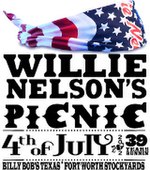Willie Nelson's Fourth of July Picnic
| Willie Nelson's Fourth of July Picnic | |
|---|---|
 |
|
| Genre | music festival |
| Date(s) | around July 4th |
| Frequency | Annually |
| Location(s) | Variable |
| Years active | 1973 - present |
| Inaugurated | July 4, 1973 |
| Most recent | July 4, 2017 (Austin, Texas) |
| Website | |
| williespicnic |
|
Willie Nelson's Fourth of July Picnic is an annual concert hosted by country music singer Willie Nelson. Nelson was inspired to create the annual concert after his participation in the 1972 Dripping Springs Reunion, that was hosted at Hurlbut Ranch in Dripping Springs, Texas. As part of the lineup, Nelson performed on the third day. The event failed to meet the expected attendance due to the concert being poorly promoted.
Interested in the concept, Nelson decided to host the first annual Willie Nelson's Fourth of July Picnic in the same place, as it was already prepared to host a concert. The success of the event led to other concerts. During the late 1970s, the bad reputation of the concert for recurrent problems with safety of the audience made it difficult to find venues. During the 1980s the security improved, and the event recovered the trust of the potential venues.
Willie Nelson was inspired to start a yearly festival by the 1972 Dripping Springs Reunion, where he was a part of the lineup. In 1971, four music promoters from Dallas, Texas, decided to create a massive music festival for country music audiences. Edward Allen, Michael McFarland, Don Snyder and Peter Smith, chose the Hurlbut Ranch, owned by James Hurlbut in Dripping Springs, Texas to be the place for the festival. After working on the grounds for months to prepare the site, the festival was set to last three days, between March 17-19, 1972. The lineup included Earl Scruggs, Hank Snow, Sonny James, Tom T. Hall, Tex Ritter, Roy Acuff, Willie Nelson, Waylon Jennings and Kris Kristofferson. Due to the lack of funds, the event was poorly promoted. The expected total attendance was 180,000 to 225,000 for the three days, but it failed to reach 40,000. Security was provided by 123 men on foot, 40 perimeter horse riders, highway patrolmen and two helicopters. According to Nelson's biographer Joe Nick Patoski, the concert "helped spark the rise of progressive country music and recognition of Austin as a music hub".
...
Wikipedia
